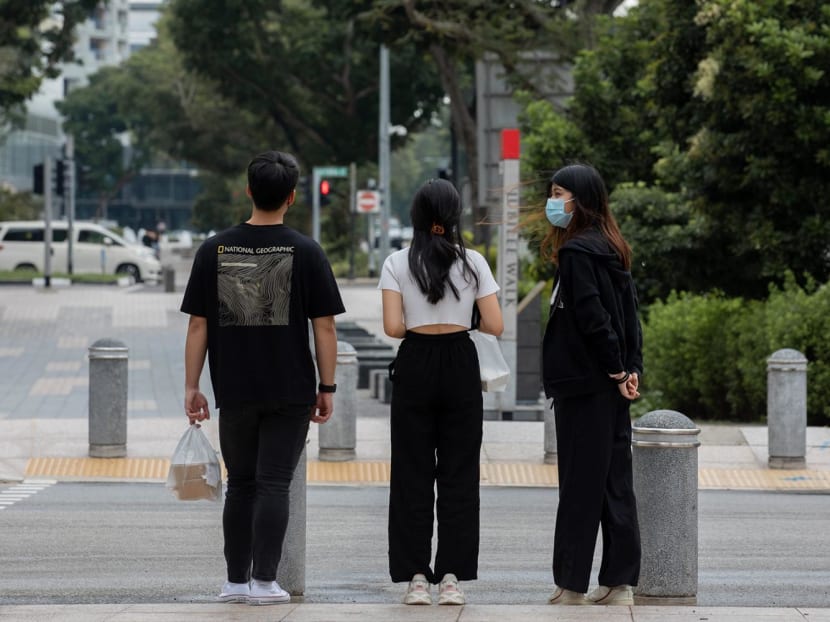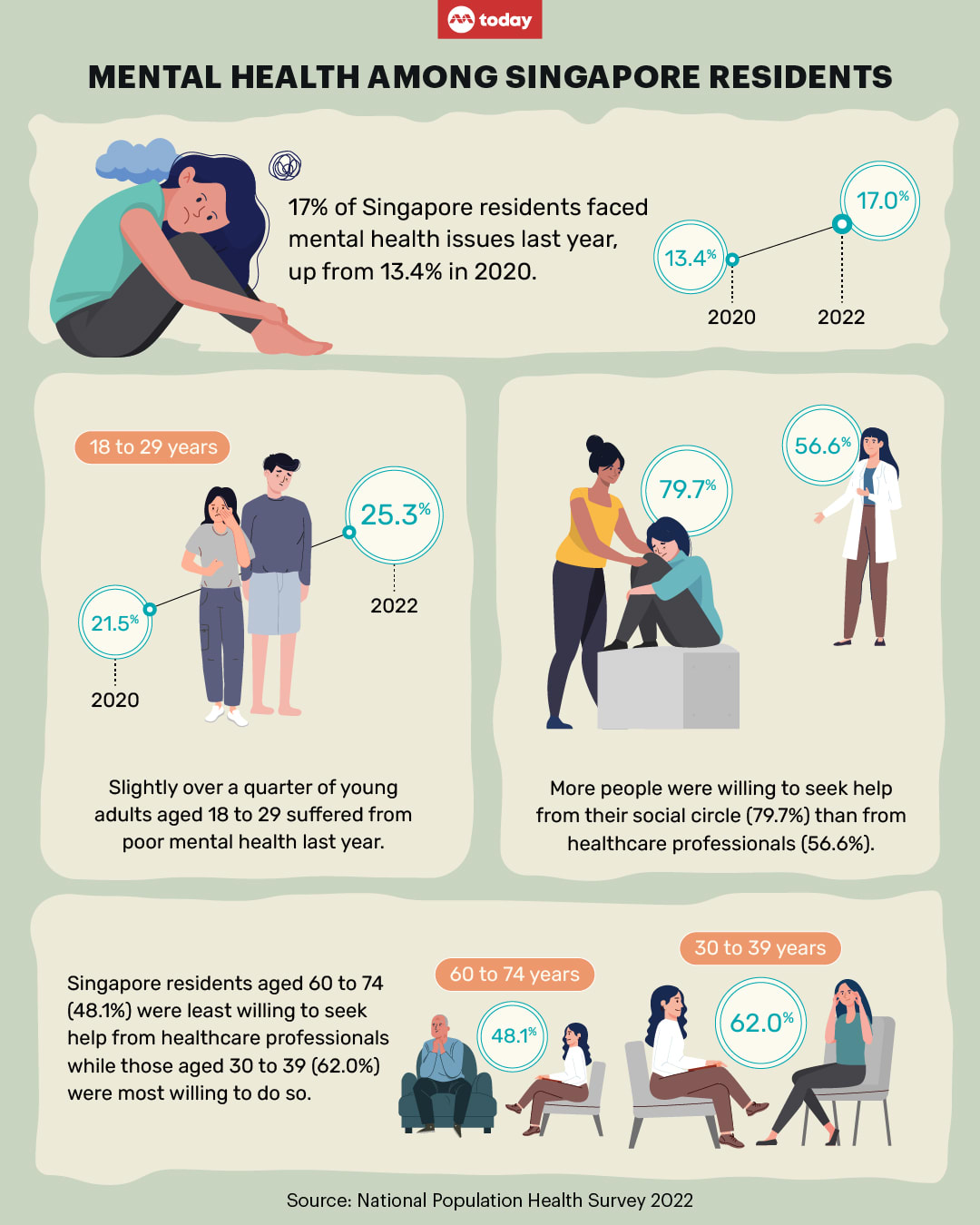Highest proportion among youths aged 18-29 with poor mental health, rising to over 25%: National health survey

Follow us on Instagram and Tiktok, and join our Telegram channel for the latest updates.
- The Ministry of Health released the results of the 2022 National Population Health Survey
- It found that the highest proportion of people with poor mental health were from the 18 to 29 age group at 25.3 per cent
- More Singapore residents were willing to seek informal help when they were unable to cope with stress
- They would approach friends, relatives or religious leader, for example
- As for the Health Promotion Board's 2022 National Nutrition Survey, it showed worrying trends such as a higher sodium intake and an increased calorie consumption among Singapore residents
BY
CHARLENE GOH
Published September 27, 2023Updated September 27, 2023
WhatsAppTelegramFacebookTwitterEmailLinkedIn
SINGAPORE — Slightly over a quarter of Singapore residents aged 18 to 29 suffered from poor mental health last year, a national survey has found.
This group of youth made up the highest proportion of residents who faced mental health issues compared to other age groups, the Ministry of Health (MOH) said on releasing its findings from the 2022 National Population Health Survey on Wednesday (Sept 27).
The proportion of young people dealing with mental health issues in 2022 — 25.3 per cent — was an increase from the 21.5 per cent in 2020.
In comparison, the prevalence of poor mental health in those aged 30 to 39 was 19.4 per cent last year, a rise from 12.6 per cent in 2020.
For those aged 40 to 49, the proportion was 15.7 per cent, up from 12.4 per cent in 2020.
READ ALSO
Parents worried about stigma over mental health may be obstacle to youth seeking help: Forum panellists
Overall, 17 per cent of Singapore residents faced mental health issues last year, up from 13.4 per cent in 2020.
However, more people were also willing to seek informal help — such as from friends, relatives or religious leaders — when they were unable to cope with stress, the study found.
MOH's survey tracked the health and risk factors, as well as lifestyle practices of Singapore residents aged 18 to 74 between July 2021 to June 2022.
As part of the study, about 8,000 residents completed household interviews and around 9,000 attended a health examination.
'REDUCED STIGMA'
The increase in "help-seeking behaviour" displayed by Singapore residents in response to stress "reflects continued public awareness of mental health, and reduced stigma around mental health conditions", MOH said on Wednesday.The study found that more people on the whole were willing to seek help informally from their social circle (79.7 per cent) than from healthcare professionals (56.6 per cent) if they were constantly unable to cope with stress.
Informal support networks include friends, relatives and teachers, while healthcare professionals include counsellors and psychologists.
However, the proportion of residents who were willing to seek informal help decreased with age, the study found.
The 18-to-29 age group was the most willing (88.1 per cent) to seek help informally. Older adults aged 60 to 74 were the least willing, with 68.4 per cent saying they would seek help.
As for seeking help from healthcare professionals, 60.1 per cent of those aged 18 to 29 said that they would do so.
This was even lower (48.1 per cent) among older adults aged 60 to 74.
Those aged 30 to 39 years (62.0 per cent) were the most willing to do so.
Females were also more willing to seek help from healthcare professionals and informal support networks compared to males, the study found.

NUTRITION STUDY
In a separate survey by the Health Promotion Board (HPB), the findings revealed some unhealthy dietary trends among residents last year.These included rises in sodium intake and calorie consumption among Singapore residents.
HPB's 2022 National Nutrition Survey monitored the dietary patterns and nutritional status of 3,000 Singapore residents aged 18 to 69 from December 2021 to August 2022.
Although this National Nutrition Survey found that sugar consumption had declined since 2018, sodium intake remained high.
The daily sodium intake of the population increased from 3,480mg in 2019 to 3,620mg in 2022.
READ ALSO
Seeking self-help, mental health coaches? Here's what to look out for
Nine in 10 Singapore residents exceeded the daily recommended sodium intake of less than 2,000mg, which is equivalent to one teaspoon of salt. This was a slight rise from 88 per cent in the last study done in 2019.
A key source of sodium consumption is the salt and sauces added during cooking, as well as in meals eaten outside of home, HPB said.
Soupy dishes were the main source of sodium, followed by convenience foods and gravy or sauce-based dishes.
HPB added that on average, sodium content for every dish sold outside has increased by 22 per cent from 2010 to 2023.
This was due to increases in portion size and price increases for ingredients. This causes food operators to turn to salt — a cheaper alternative — to maintain flavour.
To address this trend, HPB had in September last year announced targets to get the population here to reduce sodium intake by 15 per cent in the next five years.
It also said then that it will make healthier salt and seasoning products more readily available to consumers, such as potassium salt that contains about half the amount of sodium compared to regular table salt.
Although the National Population Health Survey showed that there was a decreasing prevalence of diabetes and high cholesterol among Singapore residents, the prevalence of hypertension continues to rise.
Just 19.8 per cent of residents suffered from hypertension in 2010, but this figure rose to 35.5 per cent in the 2019-2020 study and 37 per cent in the 2021-2022 edition, MOH said.
A diet high in sodium is a significant risk factor for hypertension, MOH and HPB said.
Every 1g increase in salt intake a day is associated with a nearly 10 per cent increase in hypertension risk, HPB said during a media briefing on Monday ahead of the release of its survey results.
